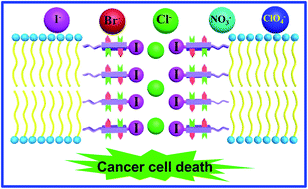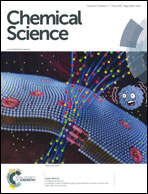A halogen bond-mediated highly active artificial chloride channel with high anticancer activity†
Abstract
Chloride-selective transmembrane carriers or channels might have possible uses in treating channelopathies or cancers. While chloride carriers have been extensively investigated, the corresponding chloride channels have remained limitedly studied. Moreover, all hitherto reported channel systems lack clearly definable and readily modifiable positions in their structures for the reliable construction and combinatorial optimization of their ion transport properties. As a result, the existing channels are limited by their large molecular weight, weak activity or low anion selectivity. In this report, we describe a readily accessible and robust monopeptide-based scaffold for the reliable construction of halogen bond-mediated artificial anion channels via directional assembly of electron-deficient iodine atoms, which create a transmembrane pathway for facilitating anion transport. The high intrinsic modularity of the backbone of the scaffold, which enables the rapid and combinatorial optimization of the transport activity and selectivity of channels, effectively delivers a highly active chloride channel A10. Such high activity in chloride transport subsequently leads to an excellent IC50 value of 20 μM toward inhibiting the growth of human breast cancer cells (BT-474), an anticancer activity that is even higher than that of the well-known anticancer agent cisplatin.

- This article is part of the themed collection: Most popular 2018-2019 supramolecular chemistry articles


 Please wait while we load your content...
Please wait while we load your content...